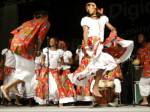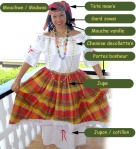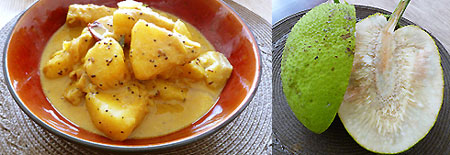- Let us dance bele!
- World Creole Music Festival is on this weekend (24-26th Oct. 2014)
- National wear – dress up!
- Crab callalloo – yummy!
Creole Language
Creole (Antillean Kwéyòl) was born out of the slavery era, Africans were assigned to the slavery plantations in the French Antilles; the French of their slave masters and their native tongues were somewhat useless as a method of communication since they spoke different tribal languages. As a result, they were forced to develop a new form of communication by relying on what they heard from their colonial masters and their fellow tribesmen.
Sporadically, they would use words they thought they heard their colonial masters speak and combine them with their African expressions and sentence structure; thus, new words were fashioned and given meaning.
Gradually, this new method of communication among the slaves spread across the regions of the Caribbean. This “Creole” language (French for “indigenous”) progressively grew into a more recognizable language.
Traditional creole national dress
The Wob Dwiyet is Dominica’s traditional costume worn by women from the 1800s to the 1960s, and is now only seen at national festivals such as independence celebrations. Starting life as a dress worn on Sundays or feast days when slave women were able to discard their drab uniforms and dress up in the kind of colours to which they were accustomed, and the traditional Creole Wob Dwiyet was born. Over the years the style has been modified and accessories have been added to develop this attire but the combination of bright skirt over white chemise, with lace adornments, coloured head scarf and kerchief is in essence the same as the national dress that is worn today.
The wearer of the wob dwiyet is known as the matador and on formal occasions she may choose to wear a headpiece, or tete en l’air, made of a square piece of madras. The dress is worn with pride and poise as it displays the island woman’s innate strength and confidence in herself and pride in her island. This square of Indian cotton, made by the Kalabari in the vicinity of Chennai (formerly Madras), was known as the mouchoir madras and became very popular with Creole women towards the end of the 18th century. French, English and Portuguese merchants were involved in the trade of madras, or injiri, as it is known in India, around 400 years ago. It is thought these merchants brought the material to west Africa where it was worn by the Igbo in southern Nigeria.
The men wear long black pants and a white long sleeve dress shirt with a red satin. Madras is used to decorate this attire in the form of ties, large waist bands or waist coats.
Creole traditional dance
QUADRILLE: A square dance of French origin. Four couple dance opposite and with each other. In the original Quadrille there are five separate and complete figures. The whole forms a set of Quadrille. This can take some time to complete, and since most are now done as public performances rather than for personal amusement, a number of sets are usually cut out. The pace of the quadrille has naturally been quickened and among the types danced today are the ‘Sharp’ ‘Slow’, ‘French’ and ‘Irish’ Quadrilles.
LANCERS: This is a later quadrille which came via Britain in the 1830’s and contained familiar figures from the traditional English dances and Scottish and Irish reels. It was popular with the military and the steps of the male have a more stiff and formal pace.
MAZOOK: From the Mazurka which had its origins in Poland but was very popular in France and so came to the West Indies. The steps have great variety but the music pattern starts with a smooth glide on the third note, shuffle step for the next note, another smooth glide and a series of cross steps until one is back to the first position. A special feature is the clicking and raising of the heels at the end of each round in the Heel and Toe Polka Mazook.
BÉLÉ: This probably is the earliest Creole dance which also has the strongest, virtually untouched African pattern. It has its roots in mating and fertility dance rites. There is a single instrument – the tambou drum – which is properly made of goat skin stretched over a hallowed tree trunk. The drum rhythm follows the steps of the single dancer who performs in a circle of spectators who also form the chorus or lavway for the lead or chantuelle. Although there are two dancers, only one usually dances at a time except at the end. The pattern usually is:-
- Cavalier show physical style and prowess.
- Dam shows approval and tempts him.
- The Cavalier seeks the Dam once more.
- Both dance in the most heated piece.
In all pieces dancing is directed towards the drum. Bélé is noted for the deep booming drum very vigorous body movement and steps, high pitched lavway with short and simple wording.
Creole music
Jing ping
Jing Ping is a kind of folk music originated on the slave plantations of Dominica, also known colloquially as an accordion band. In Dominican folk music, jing ping bands accompany a circle dance called the flirtation, as well as the Dominican quadrille. Jing ping bands are made up of boumboum (boom pipe usually made with a piece of bamboo) syak or gwaj (scraper-rattle), tambal or tabou (tambourine) and accordion. The double bass and banjo are also sometimes used. Bamboo flutes led the jing ping ensembles before the 1940s, when accordions were introduced.
Chanté mas
The chanté mas (masquerade song) tradition is based around pre-calypso Carnival music performed in a responsorial style by partygoers. The Dominican Carnival masquerade lasted for two days of parading through the streets, with a singer dancing backwards in front of the drummer on a tanbou lélé. Chanté mas lyrics are traditionally based on gossip and scandal, and addressed the personal shortcomings of others.
Other folk music
Dominica’s folk musical heritage includes work songs, storytelling, children’s music and masquerade songs. Dominican work songs are accompanied by the tambou twavay drum, and are performed by workers while gathering fruit, building roads, fishing, moving a house or sawing wood. Many are responsorial, and are generally short and simple, with the lyrical text and rhythm tying into the work to be accompanied. On modern Dominica, work songs are rarely performed.
The kont, or storytelling, folk tradition of Dominica was focused around entertainment for night-time festivals, funeral wakes and feasts and festivals. Modern kont is mostly performed during major festival competitions. Most kont storytellers work with local traditions, such as legends and history, and provide an ethical or moral message. A one line theme song, often based around a duet between two characters, recurs throughout most kont performances.
Unlike most Dominican folk songs, children’s songs and musical games are mostly in English. They were originally in the same Creole as the rest of the island, but have come to be primarily of English, Scottish, and Irish derivation. Children’s musical traditions include ring games and circle dances, and music accompanied by thigh-slapping and circle dancing.
Calypso
In the sixties, calypso and steelband music became very popular and indeed replaced lapo kabwit and chanté mas as the music of carnival, particularly in the capital Roseau. Many of the traditional songs were performed in the new calypso beat. Calypsonians and calypso monarch competitions emerged and became extremely popular. Steelbands emerged all around the country. The older musicians and bands had moved on and were replaced by the younger musicians. Bands such as Swinging Stars, The Gaylords, De Boys an Dem, Los Caballeros and Swinging Busters surfaced and began to cut records. The emergence of radio, first WIDBS and later Radio Dominica helped to spread the music.
Calypso has been popular in Dominica since the 1950s; the first Calypso King was crowned in 1959. Popular calypso in Dominica has always been closely associated with steelpan music. The first wave of Dominican steelpan includes bands like Esso, Shell and Regent, Vauxhall and Old Oak.
Cadence (kadans)/compas
In the 1970s, a wave of Haitian, mostly musicians, to Dominica and the French Antilles (Guadeloupe and Martinique) brought with them the kadans, a sophisticated form of music that quickly swept the island and helped unite all the former French colonies of the Caribbean by combining their cultural influences. This was followed by mini-jazz like Les Gentlemen, Les Leopards, Les Vikings de Guadeloupe and others.
Later in the decade and into the 1980s, the French Antilles became home to a style of cadence music called cadence-lypso. Gordon Henderson’s Exile One innovated this style, as well as turned the mini-jazz combos into guitar-dominated big bands with a full-horn section and the newly arrived synthesizers, paving the way for the success of large groups like Grammacks, Experience 7, among others. Drawing on these influences, the supergroup Kassav’ invented zouk and popularized it with hit songs like “Zouk-La-Se Sel Medikaman Nou Ni”. Kassav’ formed from Paris in 1978.
Cadence-lypso (Dominica kadans)
The most influential figure in the promotion of Cadence-lypso was the Dominican group Exile One (based on the island of Guadeloupe) that featured mostly the cadence rampa of Haiti and calypso music from the English speaking caribbean. It was pushed in the 1970s by groups from Dominica, and was the first style of Dominican music to find international acclaim.
Dominica cadence music has evolved under the influence of Dominican and Caribbean/Latin rhythms, as well as rock and roll, soul, and funk music from the United States. By the end of the 1970s, Gordon Henderson defined Cadence-lypso as “a synthesis of Caribbean and African musical patterns fusing the traditional with the contemporary”.
Aside from Exile One, other bands included the Grammacks, Black Roots, Black Machine, Naked Feet, Belles Combo, Mantra, Black Affairs, Liquid Ice, Wafrikai, Midnight Groovers and Milestone, while the most famous singers included Bill Thomas, Chubby Marc, Gordon Henderson, Linford John, Janet Azouz, Sinky Rabess, Tony Valmond, Jeff Joseph, Mike Moreau and Anthony Gussie. Ophelia Marie is a popular singer of cadence-lypso in the 1980s.
Cadence-lypso was influenced by nationalist movement that espoused Rastafari and Black Power. Many groups performed songs with intensely ideological positions, and much of the repertoire was in the vernacular kwéyòl language.
Bouyon
Bouyon is a fusion of Jing ping, Cadence-lypso and traditional dances namely bèlè, quadrille,
chanté mas and lapo kabwit, Mazurka, Zouk and other styles ofCaribbean music, developed by a band called Windward Caribbean Kulture (later WCK). WCK was among the most prominent of ’80s Dominican soca bands. They began using native drum rhythms such as lapo kabwit and elements of the music of jing ping bands, as well as ragga-style vocals. Bouyon is popular across the Caribbean, and is known as jump up music in Guadeloupe and Martinique.
The best-known band in the genre was Windward Caribbean Kulture “WCK” in 1988 by experimenting a fusion of Jing Ping and Cadence-lypso. While the Cadence-lypso sound is based on the creative usage of acoustic drums, an aggressive up-tempo guitar beat, and strong social commentary in the local Creole language, this new music created by the “WCK” band focused more on the use of modern technology with strong emphasis on keyboard rhythmic patterns.
The World Creole Music Festival, three nights of pulsating rhythms, held annually in October is a huge celebration of creole music and culture.
Creole Cuisine
Dominica’s cuisine is similar to many other Caribbean island. Its cuisine has a distinct twist to its cuisine. Breakfast is an important meal in Dominica and is eaten every day. Typically eaten meals include salt-fish (which is imported dried and salted codfish) and bakes (made by making dough and frying it in oil). Salt-fish stuffed bakes also doubles up as a fast food snack that can be eaten throughout the day. Snack shops and roadside vendors sell these snacks to passers-by, as well fried chicken and fish.
Salt-fish or smoked herrings shredded and stewed in onion and green seasoning served with boiled green banana or breadfruit roasted over an open fire (with the charred exterior and internal seeds removed, of course) are popular traditional dishes served at lunch time. Ground provisions and local produce are commonly eaten. Meat and poultry typically eaten include chicken (which is very popular), beef, fish which are normally stewed down with fresh tomatoes, onions, carrots, garlic, ginger and herbs like thyme and using the browning method to create a rich dark sauce. Coconut cream/milk features highly in meals cooked creole style. Locally made juices are served throughout the day which are made with locally produced exotic fruits, including grapefruit, oranges, guava, soursop, passion fruit, pineapples, ripe bananas and mangoes, which can also be eaten as dessert.
Dominica’s national dish is callalloo, a soup made from blended dasheen leaf with meat (often smoked) and crab during the crab hunting season (during independence celebrations – September to November), seasonings, chopped vegetables, root crops, such as yams, dasheen, potato, or green banana and plantains added. Coconut milk may be added to get it thicker and to enhance the flavor.
The national dish used to be mountain chicken, a species of frog, which is now endangered.
Sources: Dominica: the Bradt Guide, Wikipedia.com, SearchDominica.com & Lennox Honychurch




